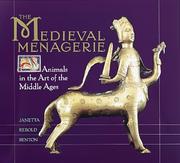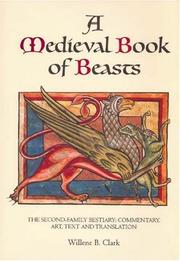| Listing 1 - 10 of 27 | << page >> |
Sort by
|
Book
ISBN: 9783799508032 Year: 2008 Publisher: Ostfildern Thorbecke
Abstract | Keywords | Export | Availability | Bookmark
 Loading...
Loading...Choose an application
- Reference Manager
- EndNote
- RefWorks (Direct export to RefWorks)
Book

ISBN: 2234012171 9782234012172 Year: 1980 Volume: 35 Publisher: Paris Stock
Abstract | Keywords | Export | Availability | Bookmark
 Loading...
Loading...Choose an application
- Reference Manager
- EndNote
- RefWorks (Direct export to RefWorks)
Iconography --- anno 500-1499 --- 840 "-/14" --- 091:59 --- 091 =40 --- Franse literatuur--?"-/14" --- Handschriftenkunde. Handschriftencatalogi-:-Zoologie. Dierkunde --- Handschriftenkunde. Handschriftencatalogi--Frans --- 091 =40 Handschriftenkunde. Handschriftencatalogi--Frans --- 091:59 Handschriftenkunde. Handschriftencatalogi-:-Zoologie. Dierkunde --- Old French literature --- bestiaries --- Animalia [kingdom]
Book
ISBN: 8842210943 Year: 2001 Publisher: Torino : U. Allemandi,
Abstract | Keywords | Export | Availability | Bookmark
 Loading...
Loading...Choose an application
- Reference Manager
- EndNote
- RefWorks (Direct export to RefWorks)
091:59 --- 091:59 Handschriftenkunde. Handschriftencatalogi-:-Zoologie. Dierkunde --- Handschriftenkunde. Handschriftencatalogi-:-Zoologie. Dierkunde --- Bestiaries --- Animals, Mythical, in art --- Bestiaires --- Animaux fabuleux dans l'art --- Animals in art --- Animaux dans l'art --- History --- Histoire --- Animaux --- Créatures fabuleuses --- Dans l'art.

ISBN: 1558591338 Year: 1992 Publisher: New York, N.Y. Abbeville Press
Abstract | Keywords | Export | Availability | Bookmark
 Loading...
Loading...Choose an application
- Reference Manager
- EndNote
- RefWorks (Direct export to RefWorks)
Iconography --- Zoology --- anno 1200-1499 --- Europe --- 091.31:7.04 --- 091:59 --- Animals in art --- Art, Medieval --- Medieval art --- Animal painting and illustration --- Pets in art --- Wild animals in art --- Zoo animals in art --- Verluchte handschriften: iconografie --- Handschriftenkunde. Handschriftencatalogi-:-Zoologie. Dierkunde --- Animals in art. --- Art, Medieval. --- 091:59 Handschriftenkunde. Handschriftencatalogi-:-Zoologie. Dierkunde --- 091.31:7.04 Verluchte handschriften: iconografie

ISBN: 9042916222 Year: 2005 Volume: 16 Publisher: Leuven Peeters
Abstract | Keywords | Export | Availability | Bookmark
 Loading...
Loading...Choose an application
- Reference Manager
- EndNote
- RefWorks (Direct export to RefWorks)
Philosophy of nature --- anno 500-1499 --- Antiquity --- Natuurfilosofie --- Philosophie de la nature --- Nature --- Religious aspects --- History of doctrines --- History --- 091:58 --- 091:59 --- 113 --- Herbaria--(handschriften) --- Handschriftenkunde. Handschriftencatalogi-:-Zoologie. Dierkunde --- Philosophy Cosmology --- 091:59 Handschriftenkunde. Handschriftencatalogi-:-Zoologie. Dierkunde --- 091:58 Herbaria--(handschriften) --- Nature, Philosophy of --- Natural theology --- Philosophy

ISBN: 9780851156828 0851156827 Year: 2013 Publisher: Woodbridge Boydell
Abstract | Keywords | Export | Availability | Bookmark
 Loading...
Loading...Choose an application
- Reference Manager
- EndNote
- RefWorks (Direct export to RefWorks)
Book history --- Thematology --- Medieval Latin literature --- bestiaries --- illuminated manuscripts --- animal art --- books --- Bestiaries. --- Bestiaries --- Bestiaires --- 091:59 --- Handschriftenkunde. Handschriftencatalogi-:-Zoologie. Dierkunde --- 091:59 Handschriftenkunde. Handschriftencatalogi-:-Zoologie. Dierkunde --- Illustrated books --- History and criticism --- Painting --- History and criticism. --- Histoire et critique --- Bestiaries - History and criticism
Book
ISBN: 9782251448688 2251448683 Year: 2018 Publisher: Paris : Les Belles lettres,
Abstract | Keywords | Export | Availability | Bookmark
 Loading...
Loading...Choose an application
- Reference Manager
- EndNote
- RefWorks (Direct export to RefWorks)
Papauté --- Papacy --- Animaux --- Animals --- Symbolisme chrétien --- Christian art and symbolism. --- Aspect symbolique --- Symbolic aspects --- Christian art and symbolism --- Symbolic aspects. --- Symbolisme chrétien. --- Aspect symbolique. --- --Aspects symboliques --- --Animal --- --Symbolisme chrétien --- --Papauté --- 091:59 --- 091:59 Handschriftenkunde. Handschriftencatalogi-:-Zoologie. Dierkunde --- Handschriftenkunde. Handschriftencatalogi-:-Zoologie. Dierkunde --- --091:59 --- Aspects symboliques --- Animal --- Papauté --- Symbolisme chrétien.
Book
ISBN: 9780789211279 0789211270 Year: 2012 Publisher: New York Abbeville Press Publishers
Abstract | Keywords | Export | Availability | Bookmark
 Loading...
Loading...Choose an application
- Reference Manager
- EndNote
- RefWorks (Direct export to RefWorks)
"The Grand Medieval Bestiary: Animals in Illuminated Manuscripts is a splendid pageant of the animal kingdom as the Middle Ages saw it, illustrated with miniatures of every period and style, many never before published. Noted art historian Christian Heck explains that the prevalence of animals in illuminated manuscripts reflects their importance in medieval thought, an importance due in part to the agricultural society of that age, in which a variety of species--and not just docile pets--were the daily companions of man. The main part of the book explores the complex and fascinating iconography of the individual creatures most frequently depicted by medieval miniaturists. It is arranged in the manner of a proper bestiary, with essays on one hundred animals alphabetized by their Latin names. The selection includes a number of creatures that would now be considered fantastic, including the griffin, the manticore, and of course the fabled unicorn, tamable only by a gentle maiden."--
Manuscripts. Epigraphy. Paleography --- bestiaries --- illuminated manuscripts --- animal art --- Animals in art --- Animals, Mythical, in art --- Illumination of books and manuscripts, Medieval --- 091:59 --- 091:59 Handschriftenkunde. Handschriftencatalogi-:-Zoologie. Dierkunde --- Handschriftenkunde. Handschriftencatalogi-:-Zoologie. Dierkunde --- Animal painting and illustration --- Pets in art --- Wild animals in art --- Zoo animals in art --- Painting, Medieval --- Themes, motives
Book
ISBN: 9782503600826 Year: 2022 Publisher: Turnhout Brepols Publishers
Abstract | Keywords | Export | Availability | Bookmark
 Loading...
Loading...Choose an application
- Reference Manager
- EndNote
- RefWorks (Direct export to RefWorks)
Composé vers 1210 par Guillaume, un clerc laïc originaire de Normandie et habitant l’Angleterre, le Bestiaire divin est la traduction versifiée du texte de la première famille du Bestiaire latin augmenté de sermons empruntés à d’autres sources et de développements de l’auteur. Il comprend généralement trente-neuf chapitres précédés d’une préface et d’un prologue. Chaque chapitre est consacré à un animal dont les caractéristiques sont décrites puis interprétées comme autant d’allégories morales et mystiques. Les manuscrits du Bestiaire sont souvent accompagnés des représentations des animaux dont ils traitent. Ces enluminures jouent un rôle important en éclairant le sens de ces ouvrages, comme supports iconographiques permettant de dépasser l’apparence des animaux, leur sens littéral, pour en saisir la dimension allégorique. Dédié à un seigneur laïc, le Bestiaire divin témoigne du passage d’un texte relevant initialement d’une littérature didactique destinée aux écoles monastiques et capitulaires, dans la sphère de la littérature courtoise d’édification. Par sa traduction vernaculaire, le Bestiaire, initialement conçu pour faciliter l’exégèse biblique, devient un ouvrage d’édification morale à vocation parénétique accessible à un lectorat laïc. Le Bestiaire divin nous a été transmis par vingt-cinq témoins, dont la moitié sont enluminés mais le manuscrit de Paris, BnF, français 14969, enluminé dans le sud de l’Angleterre vers 1265-1270, est un des rares qui comprend l’illustration des interprétations allégoriques des animaux.
Bestiaries --- Animals in art --- Animals in literature. --- Illumination of books and manuscripts, Medieval --- Illustrations --- Guillaume, --- 091.31 <44> --- 091.31 "12" --- 091:59 --- 091:59 Handschriftenkunde. Handschriftencatalogi-:-Zoologie. Dierkunde --- Handschriftenkunde. Handschriftencatalogi-:-Zoologie. Dierkunde --- 091.31 "12" Verluchte handschriften--13e eeuw. Periode 1200-1299 --- Verluchte handschriften--13e eeuw. Periode 1200-1299 --- 091.31 <44> Verluchte handschriften--Frankrijk --- Verluchte handschriften--Frankrijk
Book
ISBN: 841809592X 9788418095924 Year: 2022 Publisher: Buenos Aires: Miño y Dávila Editores,
Abstract | Keywords | Export | Availability | Bookmark
 Loading...
Loading...Choose an application
- Reference Manager
- EndNote
- RefWorks (Direct export to RefWorks)
Los Beatos fueron un particular género codicológico que prosperó entre el siglo X y la primera mitad del XIII. Su contenido fue el “Comentario al Apocalipsis” escrito por un monje oriundo de tierras cántabras activo a fines del siglo VIII: Beato de Liébana. La Península Ibérica fue el área geográfica predilecta para la reproducción de esta obra en diversos scriptoria monásticos, aunque también se confeccionaron copias en suelo itálico y francés. El trabajo itinerante de miniaturistas que llevaron consigo compilaciones de modelos y diseños quedó plasmado en la ideación y configuración de las figuras zoomorfas que pueblan los folios de estos manuscritos iluminados. Pese a que los motivos iconográficos apocalípticos básicos se reiteran en toda la serie, sus soluciones pictóricas fueron cambiando conceptual y materialmente a través de esos siglos. No solo por su cantidad sino por su complejo desarrollo, la imaginería de animales en los Beatos se basó en una retórica visual particular y variable que buscó influir en la lectio monástica. Persuadir, convencer, comprender y preservar en la memoria de los monjes los principales contenidos exegético-apocalípticos fueron los propósitos de estas constelaciones animalísticas, que construyeron un discurso visual paralelo al del relato textual, nutriéndolo y tensionándolo con otras significaciones. Estos animales no actuaron como meras figuras aleatorias, ilustrativas o decorativas del texto, sino que operaron a través de una efectiva retórica visual estructurada en la polaridad bien-mal para reforzar y ampliar los sentidos del Comentario reproducido en estos manuscritos por casi cuatro siglos. Tradujeron a nivel exegético-doctrinal lo sagrado y lo diabólico en base a los polos domesticación- salvajismo/ bestialidad, presentes en la clasificación faunística de las Etymologiae de Isidoro de Sevilla. Además, dialogaron con los zoomorfismos presentes en la cultura visual de sus entornos monásticos, incorporando incluso interesantes observaciones empíricas sobre diversas especies. --Miño y Dávila Editores
091.31 <460> --- 091.31 <469> --- 091:228 --- 091:59 --- 091:59 Handschriftenkunde. Handschriftencatalogi-:-Zoologie. Dierkunde --- Handschriftenkunde. Handschriftencatalogi-:-Zoologie. Dierkunde --- 091:228 Handschriftenkunde. Handschriftencatalogi-:-Apocalyps --- Handschriftenkunde. Handschriftencatalogi-:-Apocalyps --- 091.31 <469> Verluchte handschriften--Portugal --- Verluchte handschriften--Portugal --- 091.31 <460> Verluchte handschriften--Spanje --- Verluchte handschriften--Spanje
| Listing 1 - 10 of 27 | << page >> |
Sort by
|

 Search
Search Feedback
Feedback About UniCat
About UniCat  Help
Help News
News